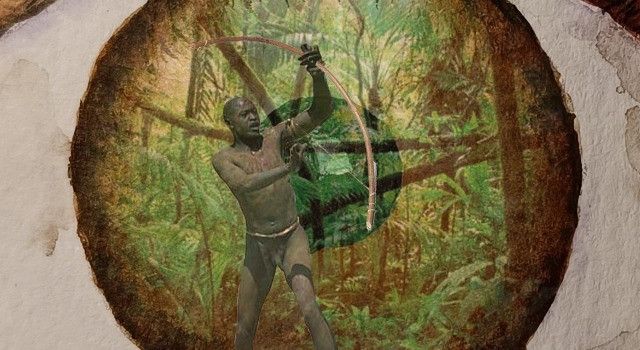
News
From sound to music
The illuminated instrument is silhouetted in the semi-darkness of the glass case. The man looks at the musical bow, a tree branch stretched by a single string of plant fibres. Nothing else. His gaze goes beyond the object. Before his eyes, imagination and ancestral memory bring images to life. The instrument comes to life in the man's mind.

1. The object and the look (draw by Oriol Rossinyol)
The illuminated instrument is silhouetted in the semi-darkness of the glass case. The man looks at the musical bow, a tree branch stretched by a single string of plant fibres. Nothing else. His gaze goes beyond the object. Before his eyes, imagination and ancestral memory bring images to life. The instrument comes to life in the man's mind.
He feels the danger. He picks up the bow. But a subtle rumble of the string spreads through the air. The wild animal, ready to pounce on its prey, hears the imperceptible vibration, the sound that will cost it its life. The man has a brief moment to fire his gun, just as the animal jumps.
This was the last pitch and the last victim of the man. His thought has been anchored in the voice of the rope. It has saved his life. From now on his existence will be linked to sound and sound objects.
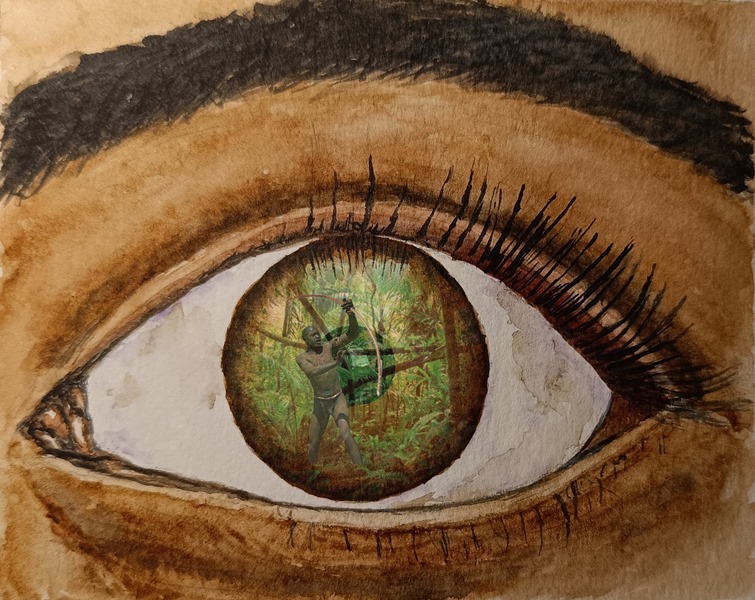
2. Sound of a single string (draw by Oriol Rossinyol)
Days, years, centuries pass. Those hands, that man, that woman, that human being, watch and listen. The object and the sound.
That faint sound, like an almost imperceptible moan, that speaks to wild beasts, is within that rope. Then, resting the bow on a log, listen to how the sound grows, the moan is a scream. Experiment, manipulate. His bow in contact with some objects raises his voice and the unknown forces of nature listen to him.
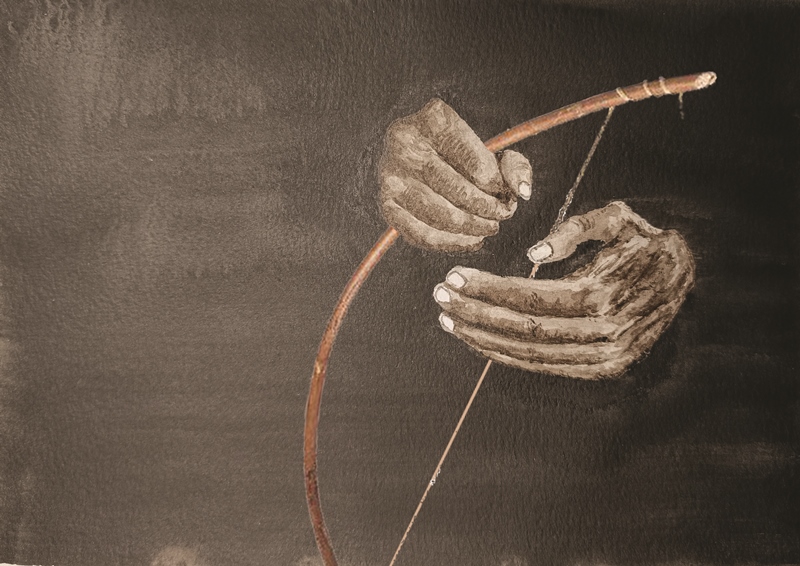
3. From object to instrument
And now he speaks with silence to that rope, he does not say words because the spirits of the jungle do not understand them. He doesn't make a sound, he just moves his mouth along the string and the sound multiplies and he speaks. And then, perhaps much later, his own voice sings the sounds hidden within the vibration of that vegetable string.
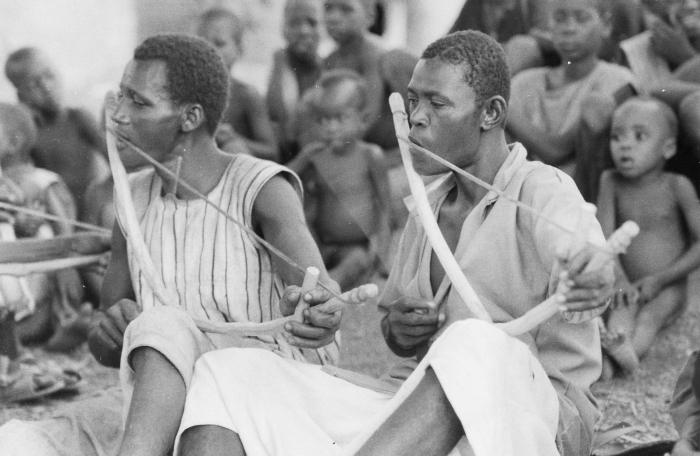
4. Musical bow and modulation with the mouth
And as days, years, centuries go by, these hands work the wit and the sound. And they transform them. Soon they will add more strings, soon the appearance of the piece will change. Soon the figures of animals and the appearance of people will be part of the sound objects. And each tool will have a function and the sound vibration that one day stopped a wild beast, now evolves and can speak the secret language of rain and thunder, of sun and night, of fire and wind, of life and death.
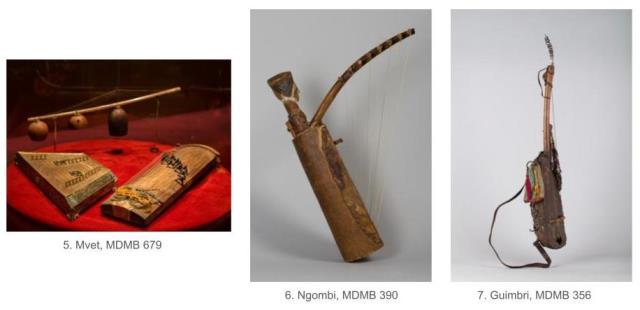
And then, these sounds, with those hands that know how to find the unseen, will heal the sick, put the child to sleep, play with the children, tell stories. They will make people dance, dream, love, transform sadness into a smile and also accompany the last farewell of those who are leaving.
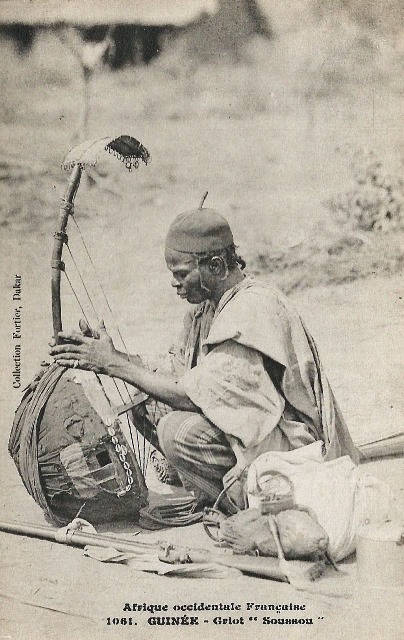
8. Griot with a kora
And one day, someone, a man, a woman, listened to those sounds that made you dance, sleep, love, remember, dream and said a word. Music. And he only listened while inside him emotion filled him.
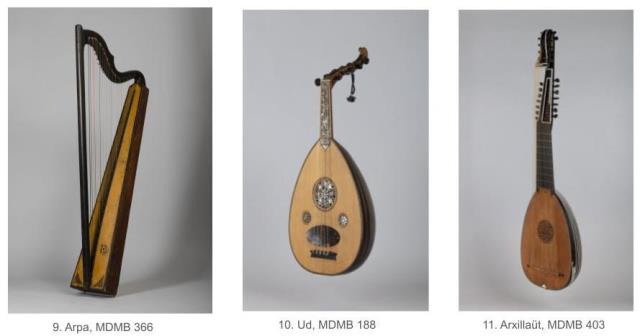
The gaze of the observer withdraws, full of history, full of life. Along the way observe in detail all those instruments descending from that arc of the African jungle. Imagine all the music in the world inside him. From the past, from now, from far away, from here. Daughter of the sound of a single string.
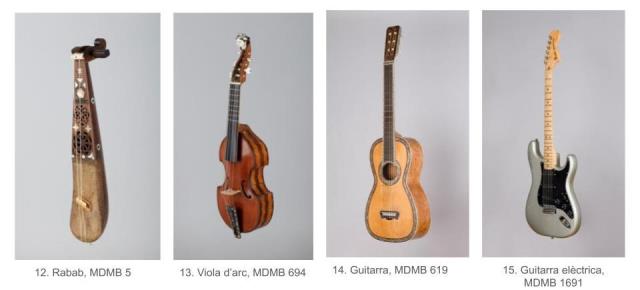
As the daylight fades and the lights of the city struggle to chase away the darkness, the observer is concentrated in a small room. The silence is broken only by an intense murmur coming from beyond the walls. In his thoughts he evokes the sound of nature, of the jungle. He picks up his guitar and goes out. The light that blinds him is of no importance next to the restlessness caused by the noise, the confusion, the call in front of her. Slowly, the acoustic commotion subsides and something close to silence fills the room.
The musician, almost as in a ritual never before celebrated, plucks a single string. With tenderness, with respect, with humility. Perhaps searching for the primary sound, the sound of that vegetable string that still vibrates inside his head. And then he moves his electric guitar closer to the speakers, searching for the hidden sounds of this moaning. The search is a dialogue, a sonorous path that takes him back to the past. Now it's all his fingers that are already fondling and manipulating the instrument. The music that emerges is full of all the sounds of history. Those that make you cry, those that make you laugh, those that make you love, those that make you dance, those that make you count, those that lead to silence. And as in a dance, man and instrument embrace, love, hate, fight. And the audience, like a jungle driven mad by the forces of nature, moves from expectant silence to a thunderous scream. The performer moves from pain to joy, from tenderness to strength, from sweetness to harshness, from fatigue to violence. Like two maddened lovers seeking total pleasure. Like two ancestral enemies fighting to the point of destruction.
And when the roar and screams of the human jungle fill the entire space, the musician walks away with his head bowed, leaving the remains of his guitar on the stage floor.

16. Jimi Hendrix amb una guitarra elèctrica
Description of the images
1. The object and the look. Painting: Oriol Rossinyol.
2. The sound of a single string. Painting: Oriol Rossinyol
3. From object to instrument. Paiting: Oriol Rossinyol
4. Musical bow (mbela) and modulation with the mouth. One of the ways to play the musical bow, in some African cultures, is to use the mouth as a sounding board while striking the string with a wooden stick. The variation of the oral cavity means that different harmonic sounds are highlighted and melodies can be made. Picture from Wikimedia Commons, of Tropenmuseum, part of the National Museum of World Cultures.
5. Mvet, MDMB 679. The sound of the string is amplified by connecting the bow to an empty cavity, for example a gourd. Photo: Sara Guasteví.
6. Ngombi. MDMB 390.The connection of the bow to a hollow trunk allows you to have a sound box and at the same time add more strings that will produce different sounds. The musical bow has been transformed into a harp. The incorporation of engravings and carvings of animal or human figures in the instruments relate the sound object to its symbolism and link it to the world of nature, spirits and ancestors. Photo: Jordi Puig,
7. Guinbri, MDMB 356. The construction of the instrument it's changing. With one or a few strings we can make many more sounds if we rest them with our finger on the structure that holds them. Photo: Jordi Puig.
8. Griot with a kora. The griot, the transmitter of culture, accompanied by a stringed musical instrument, tells his stories from village to village. The instruments will also accompany the different rituals of the people's life. Photo from Wikimedia Commons, by
9. Harp, MDMB 366. Each string a note, a path of the evolution of stringed instruments. Musical bow, ngombi, harp. Photo: Eduard Selva.
10. Ud, MDMB 188. The instrumental evolution continues. The hollowed out log is transformed into a box that can vibrate better to amplify the sound. The branch that held the strings, is now a handle worked to support the string with precision. Each culture uses its own materials and ornamentation. Photo: Jordi Puig.
11. Archlute, MDMB 403. Photo: Jordi Puig.
12. Rabab. MDMB 5. Photo: Jordi Puig.
13. Viol. MDMB 694. Photo: Jordi Puig.
14. Guitar. MDMB 619. Photo: Eduard Selva.
15. Electric guitar. MDMB 1691. Photo: Eduard Selva.
16. Jimi Hendrix (1942-1970). (picture from Wikimedia Commons, by Marjut Valakivi). He is considered one of the most influential electric guitar players in rock. Apart from his skill as a guitarist, he worked on researching the sound of the instrument and the coupling with the speakers, being a pioneer in the use of the electric guitar as a source of electronic sound.
When I started this narrative, I was very aware of the figure, the music and the life of this musician. Their African ancestors was a good start to connect the origin of stringed instruments with their ancestors. Also Hendrix's music, inspired by the blues, is an important link in the history of rock music with the musical expressions of an entire community forcibly displaced from its birthplace. This musician's search for sound, focused not only on the instrument itself but also on sound feedback with speakers, turning unwanted sounds into music, parallels the sound search of early animistic cultures and the connection with nature and the unknown world. On the other hand, the strength and vital intensity of his concerts and his premature death have served me to try to express in the description of a concert the continuity of the history of music and instruments.
Now, all I have to say is that any similarity between the text and the reality of this musician is pure coincidence. However, I want to thank Jimi Hendrix and all the musicians and luthiers whose work allows us to travel through the history of sounds and experience music intensely.

